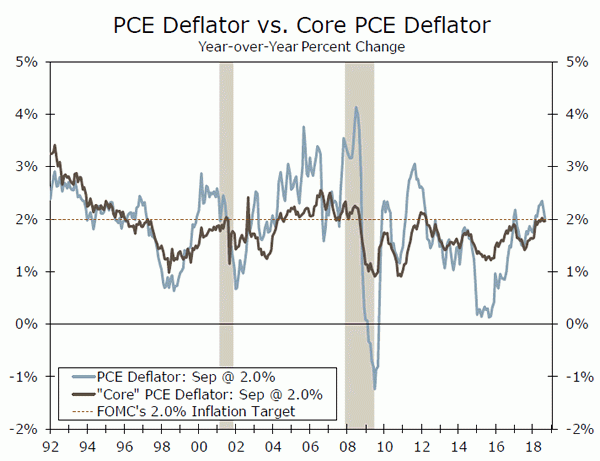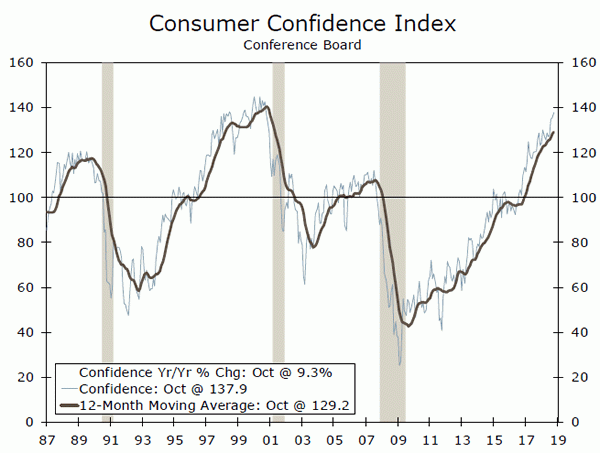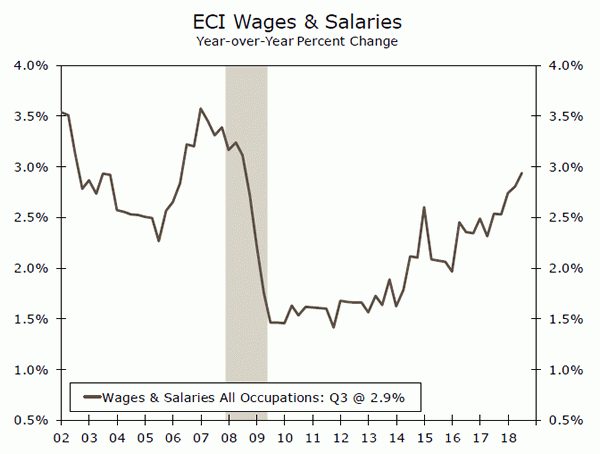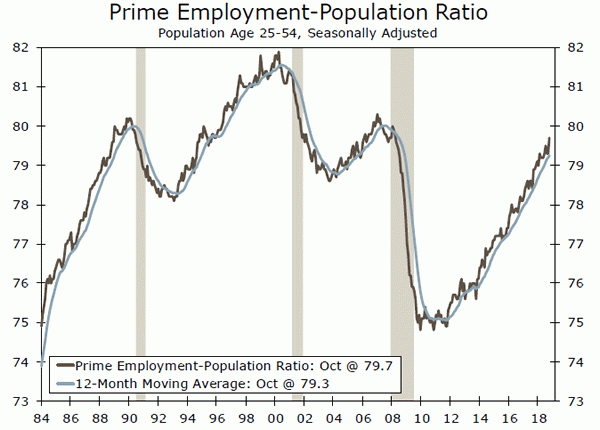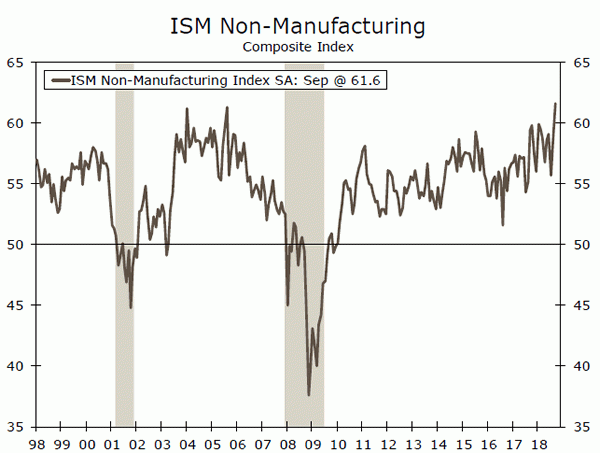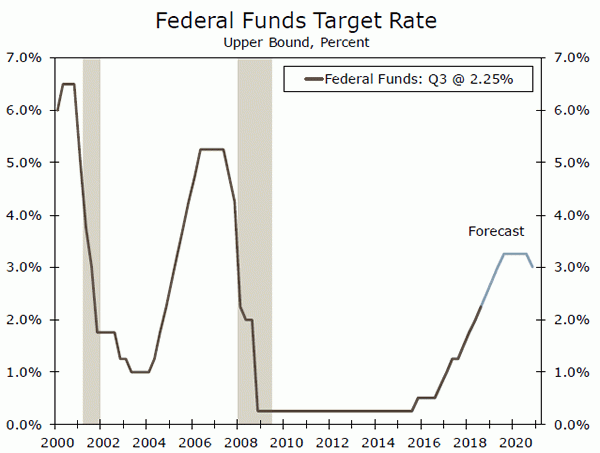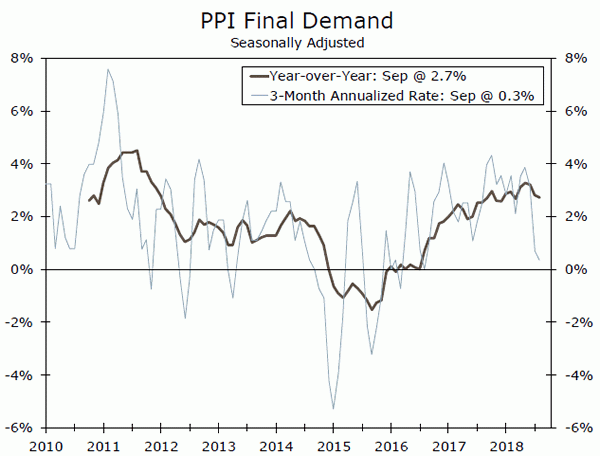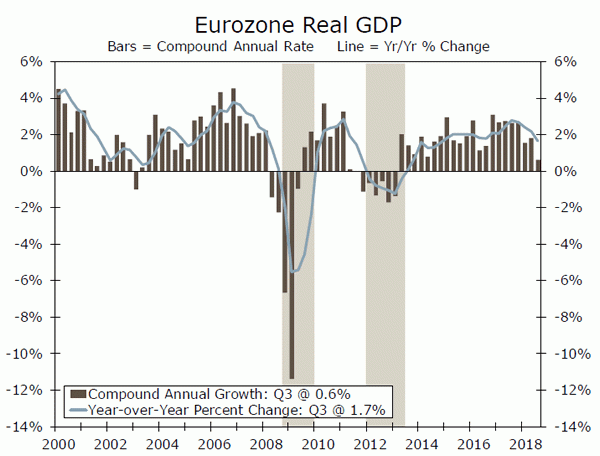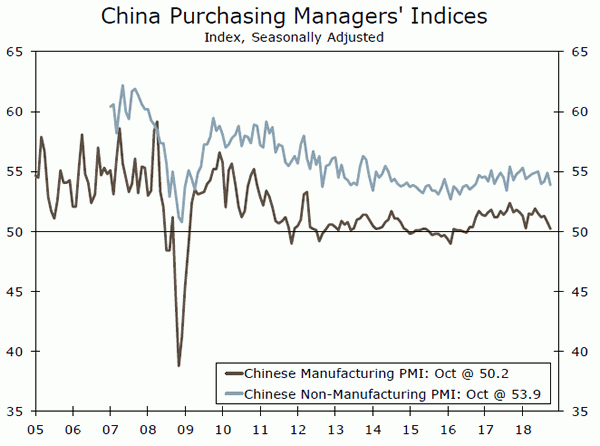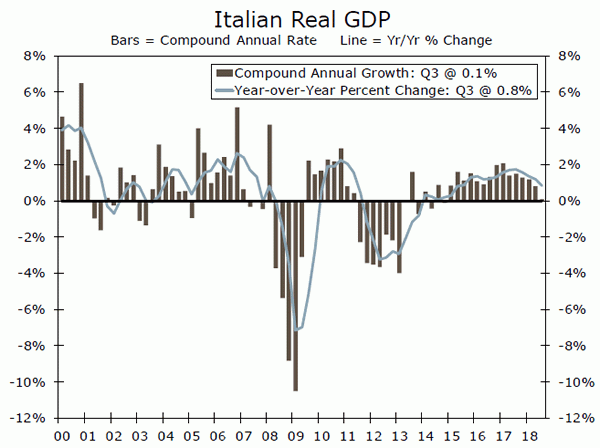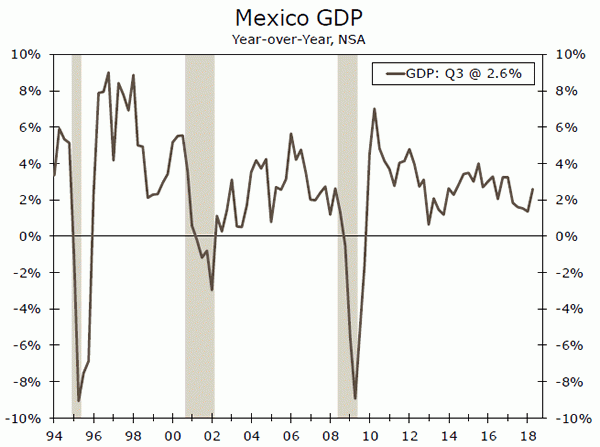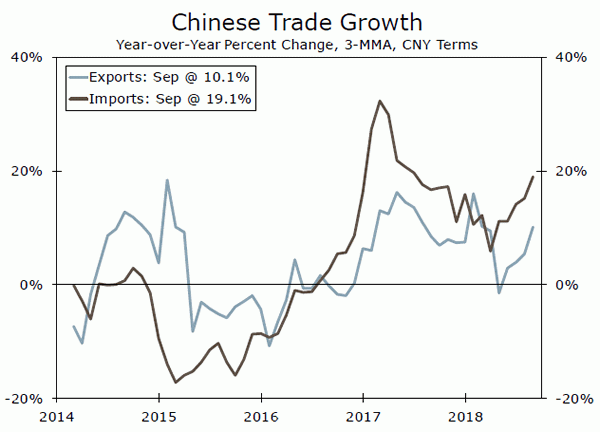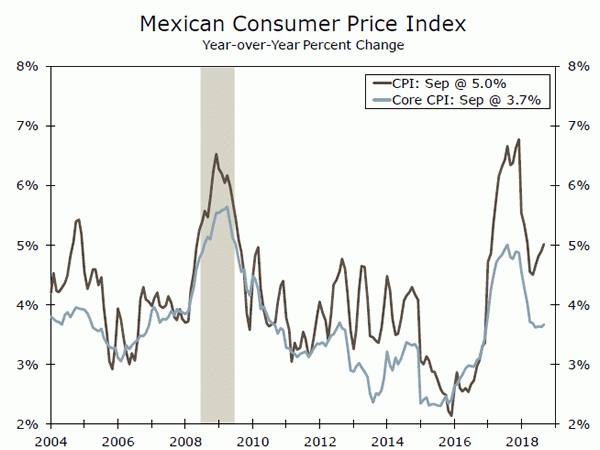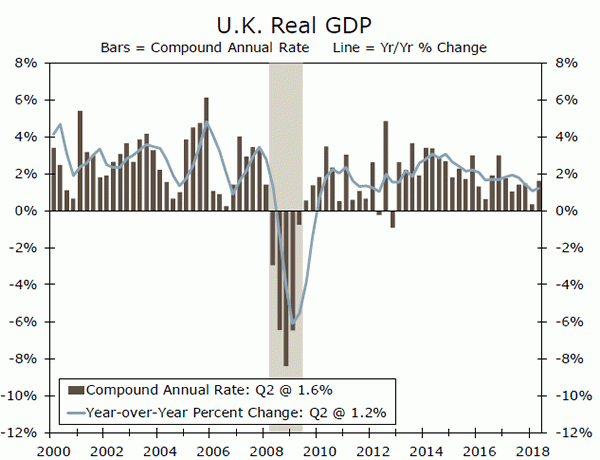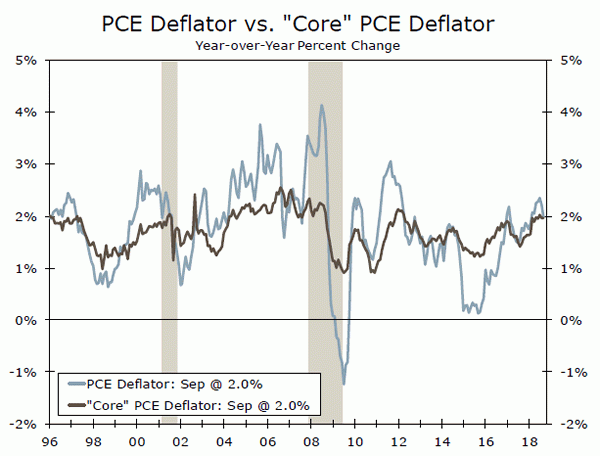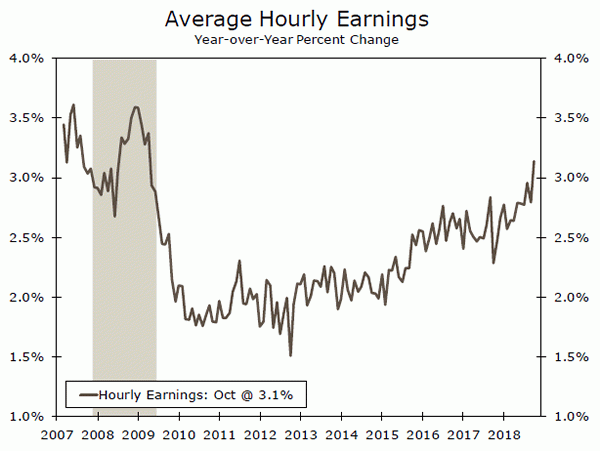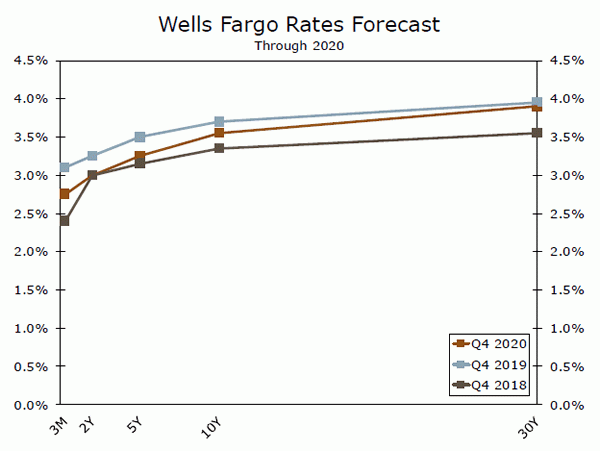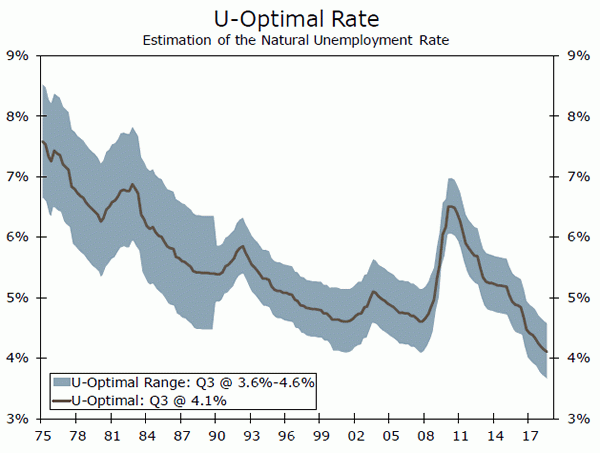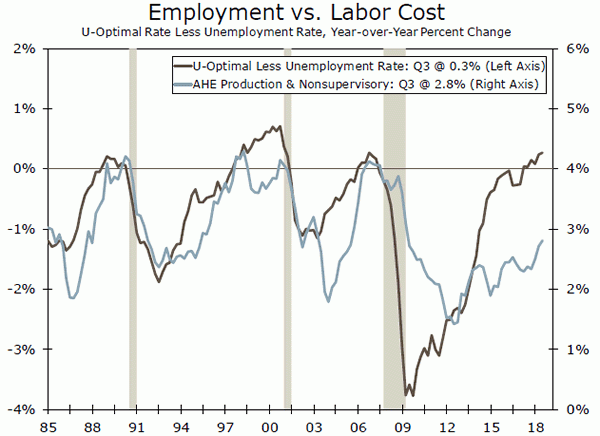U.S. Review
Volatile Financial Markets, but Solid Economic Data
- This week saw plenty of U.S. economic data released, and most of it painted a positive picture of the current state of the U.S. economy.
- The Fed’s preferred measure of inflation was right on target in September, and consumer confidence once again hit a new cycle high in October.
- Wage and salary growth also reached a cycle-high in Q3 according to data from the Employment Cost Index. Labor market tightening continued into Q4, with employers adding 250,000 jobs in October.
Volatile Financial Markets, but Solid Economic Data
This week saw plenty of U.S. economic data released, and most of it painted a positive picture of the current state of the U.S. economy. Personal spending rose a solid 0.4% in September, consistent with the robust pace of consumption reported in last week’s Q3 GDP release. Spending was driven by a surge in durables, which, at least in part, was due to replacement demand after Hurricane Florence. Perhaps of more interest was the inflation data that was contained in the personal income report. The Fed’s preferred gauge of inflation, the PCE deflator, came in right on top of the Fed’s 2.0% target for both the headline and the “core” measure (see chart on front page). With inflation still squarely on target, we believe the Fed remains on target to raise rates at its December meeting.
Boosting the case for additional Fed rate hikes was another cycle high in the Consumer Confidence Index, which hit 137.9 in October (top chart). The index is now only about seven points below the alltime high reached in January 2000 at the peak of the tech bubble. Encouragingly, the gain was driven by increases in both the present situation and expectations component. Consumers were more upbeat about job availability and income expectations, consistent with the ever-tightening labor market.
Labor market tightness was also evident in the Employment Cost Index release this week. Labor costs continued to climb over the third quarter, with the ECI increasing slightly faster than expected at 0.8%. Over the past year, the ECI is up 2.8% versus 2.5% this time last year. Compensation costs grew faster in Q3 due to a pickup in the wages component. Wages and salaries strengthened 0.9% over the quarter, and private sector wages are up 3.1% over the past year, which is the strongest pace of the expansion. Despite it being a slow grind higher, wage growth in the United States is clearly on an upward trend (middle chart), in line with what would be expected from diminishing labor market slack.
One area of weakness this week was a softer-than-expected reading from the ISM manufacturing index. Both the production and new orders components fell in October, as did the employment component. At 57.7, the index still signals that output growth in the factor sector remains solid, but the index has slipped below both its six- and 12-month moving averages. The strong dollar and trade tensions are likely offsetting some of the boost provided by the healthy domestic economy.
Finally, employment growth was 250,000 in October, surpassing already lofty expectations for a 200,000 job gain. Average hourly earnings also increased over the month and rose above a 3.0% year-over-year pace for the first time since 2009. Job growth was broad-based, with strong gains in manufacturing, education & health services and leisure & hospitality. Through the monthly noise, the tightening labor market is evident across a number of metrics. The prime age employment-population ratio, which measures what percent of the U.S. population age 25-54 is employed, continues to move higher on trend and is nearing the peak reached in the previous cycle (bottom chart).
U.S. Outlook
ISM Non-Manufacturing • Monday
Activity across the economy remained solid in September, as indicated by the ISM non-manufacturing index. The index, which includes the service sector as well as construction and mining industries, soared to a 21-year high in September of 61.6.
While last week’s GDP report suggested solid momentum heading into the final quarter of the year, we wouldn’t be surprised to see the ISM non-manufacturing index give back some of its recent gain. Trade concerns are beginning to percolate beyond the manufacturing sector, and other gauges of the service sector, including the Markit, Richmond Fed and Dallas Fed Services PMIs, have moderated from a few months ago. We estimate the ISM nonmanufacturing index fell back to 59.8 in October, which would still be consistent with activity expanding at a solid clip across the bulk of the economy.
Previous: 61.6 Wells Fargo: 59.8 Consensus: 59.0
FOMC Decision • Thursday
The previous FOMC meeting brought a widely-expected quarter-point rate hike as well as upward revisions to the Fed’s expectations for GDP growth. Rate projections submitted by the committee for the next few years were virtually unchanged and suggested that, despite removing the description of policy as “accommodative,” the near-term path of policy has not shifted.
Wednesday’s meeting will not include a press conference (the last as the Chair will hold one after each meeting next year). Another strong quarter of growth and job gains should keep the statement’s tone upbeat. We would not be surprised to see a nod to the recent volatility in financial markets, but committee members have not appeared worried about the recent moves. Therefore, we are not expecting the Fed to signal any change to the current path of policy and we expect the FOMC to leave rates unchanged before hiking again in December.
Previous: 2.00-2.25% Wells Fargo: 2.00-2.25% Consensus: 2.00-2.25%
Producer Price Index • Friday
Last month producer prices rose for the first time since June. The 0.2% gain was entirely driven by the service sector, while prices for food and energy goods declined. On a year-over-year basis, the producer price index slipped to 2.6%, but the underlying trend remains firm. Excluding food, energy and trade services (measured by margins, not selling prices), our preferred measure of core PPI was unchanged at 2.9%.
Producer prices likely rose another 0.2% in October. That should be enough to push the year-ago rate to 2.5%. Input costs have continued to increase in recent months, suggesting further price pressure. The share of manufacturers reporting higher input costs remains elevated, while the cost of intermediate services and goods is still running above finished goods and services.
Previous: 0.2% Wells Fargo: 0.2% Consensus: 0.3% (Month-over-Month)
Global Review
Global Trade Concerns Back in Focus
- Global trade fears re-emerged after U.S. President Donald Trump threatened to impose tariffs on the remainder of Chinese goods if upcoming talks with Chinese President Xi in late November do not result in a favorable trade deal. Chinese PMIs fell more than expected, adding to concerns around a more precipitous slowdown in China’s economic growth.
- In other developments, the Bank of England and Bank of Japan both held monetary policy steady as expected. Meanwhile, on the data front, Eurozone Q3 GDP grew at the slowest pace since 2014, while Mexico’s growth figures pointed to ongoing economic strength.
Global Trade Concerns Back in Focus
Markets returned their focus to global trade developments this week after a statement from U.S. President Trump that he would announce tariffs on the remainder of Chinese goods by early December if talks between Trump and Chinese President Xi did not result in a favorable trade deal. This announcement simply represents the latest escalation in U.S. rhetoric around potential further trade measures against China. Indeed, the U.S. has already imposed tariffs on $250 billion of Chinese goods, with the 10% tariff on $200 billion of those goods set to increase to 25% by year end if a deal is not reached before then. The ongoing trade conflict represents a significant downside risk for the Chinese economy, and additional U.S. tariffs could spur further policy support measures from Chinese monetary and fiscal authorities. This week’s release of Chinese PMIs added to concerns around a slowing economy, as the manufacturing PMI fell to 50.2 in October, the lowest level since 2016, although the services PMI remained firmly in expansion territory at 53.9 (top chart).
In other policy developments, meetings from major developed market central banks this week were fairly uneventful. The Bank of Japan made no change to its monetary policy stance and reaffirmed its commitment to highly accommodative monetary policy. Meanwhile, the Bank of England also held its policy rate steady, but noted rising excess demand and building domestic cost pressures, signaling an increased impetus for further rate hikes. However, we do not expect the BoE to raise rates again until it has more clarity over the Brexit situation, particularly whether the E.U. and U.K. can reach a deal before the March 2019 deadline.
On the data front, European GDP figures were generally disappointing. The Eurozone economy as a whole grew just o.2% on a sequential basis in Q2, while the year-over-year growth pace slowed to 1.7%, the lowest since 2014. Looking at the country breakdown, much of the weakness appeared to be due to stagnation in the Italian economy, where the year-over-year pace of GDP growth softened to just 0.8% in Q3 (middle chart). Those Italian GDP numbers could complicate the push by Italy’s government for more fiscal stimulus, as it has already been criticized for having overly optimistic growth targets (~1.5% nominal GDP growth). However, we doubt these growth figures are weak enough to derail the European Central Bank’s (ECB) plans to end its bond purchase program in December, while the timing and pace of initial ECB rate hikes will likely depend on the evolution of Eurozone GDP and inflation figures going forward.
Meanwhile, Mexico’s economic growth figures for Q3 were quite solid, as real GDP rose 0.9% on a sequential basis and the yearover- year growth pace picked up to 2.6% (bottom chart). Growth was fairly broadly based across different sectors of the economy, with services in particular showing strength. That said, despite strong economic data this week, Mexico’s financial markets showed outsized volatility as incoming President Andres Manual Lopez Obrador (AMLO) vowed to cancel construction of a new airport in Mexico City, raising concerns around the foreign investment climate under the incoming AMLO administration.
Global Outlook
China Trade Balance • Thursday
The Chinese economy has been at the center of global economic focus this year amid the ongoing trade tensions with the United States. China’s trade numbers have been of particular interest as the U.S. imposed tariffs on a total of $250 billion, or roughly half, of all imports from China. It is difficult to precisely quantify the effect of those tariffs on Chinese trade, but there have not been material signs of slowing in total Chinese export growth.
In fact, if anything, export growth has increased in recent months, perhaps a reflection of Chinese exporters looking to get ahead of possible further tariffs from the U.S. administration. Thus, it will be important to watch these figures in the coming months to see whether there is a continued pickup or a renewed slowdown.
Previous: $31.7B
Mexico CPI • Thursday
Mexico’s inflation has been a bit of a rollercoaster in recent years, largely reflecting significant volatility in the value of the Mexican peso versus the U.S. dollar. Peso weakness in 2016 and 2017 led to a sharp increase in CPI inflation, but price gains subsequently slowed earlier this year as the peso stabilized somewhat. In more recent months, however, inflation has moved higher, partly driven by higher oil prices (core CPI inflation has been relatively steady).
The resilience in headline CPI inflation is likely contributing to a cautious stance from Mexico’s central bank, which has hiked rates a cumulative 475 bps since 2015 and has given no signals of an intention to cut interest rates any time soon. In fact, at its latest meeting, policymakers struck a hawkish tone, suggesting rates could rise even further. In our view, Mexico’s central bank may not cut rates until 2019, and it will likely take more concrete signs that inflation is receding for the central bank to consider doing so. Previous: 5.0%
Consensus: 4.9% (Year-over-Year)
U.K. GDP • Friday
U.K. economic growth has generally underwhelmed in 2018, with real GDP rising just 1.2% year over year in Q2. If our full-year forecast for U.K. GDP growth of 1.2% is realized, it would be the weakest annual pace of U.K. GDP growth since 2009.
A closer look at activity figures suggests somewhat diverging performances among different sectors of the U.K. economy. U.K. consumers have benefitted from a pickup in a wage growth and receding inflation, with retail sales growth having picked up in recent months. Meanwhile, there are signs of weakness in the business sector, with manufacturing output growth trending lower. With Brexit uncertainty likely to persist in the coming months, it is hard to envision a significant rebound in U.K. investment activity. We expect real GDP to have risen 0.5% on a sequential basis in Q3, consistent with a 1.4% year-over-year growth pace.
Previous: 1.2% Wells Fargo: 1.4% Consensus: 1.5% (Year-over-Year)
Point of View
Interest Rate Watch
A Little Less Uncertainty
The financial markets turned around this week as some of the issues clouding the outlook cleared a bit. October’s stock market sell-off appears to have been rooted in the Fed’s belief that the extraordinarily accommodative monetary policy put in place in the aftermath of the financial crisis and painfully slow recovery was no longer needed. The Fed’s plan is to gradually return the federal funds rate to neutral or slightly above that if it needs to break the economy’s momentum.
Despite the Fed’s more heated rhetoric, the case for the Fed moving more aggressively than the path outlined in its dot plot is not very strong. Inflation has been slow to materialize (top chart) and one-off bumps in prices from trade tensions are unlikely to set off a self-reinforcing wage-price spiral.
Wages have also been slow to recover. The latest average hourly earnings data show wages rising 3.1% over the past year, the largest gain since 2009 (middle chart). The jump reflects just a 0.2% rise in October and a weak year-ago number. Wage increases in the 3%-3.5% range would be a good thing, however, and would be partially offset by productivity growth, which has risen at a 2.5% pace since tax cuts were enacted but just 1.3% over the past four quarters. If you split the difference, productivity appears set to offset half the increase in wages, which should keep inflation near the Fed’s target of 2%.
Trade tensions may also be set to deescalate. We have long felt tariffs were being used as a negotiating tool and some accommodation would be reached following the November election. Both sides felt their position would be strengthened by the midterm results. A divided Congress would create a little more political theatre in the U.S. but would not threaten to undermine the progress made by reducing taxes and burdensome regulations, allowing U.S. growth to continue along its recent stronger path.
Long-term rates dipped this week, even as the financial markets strengthened. We see interest rates continuing to gradually move higher (bottom chart), as confidence grows that U.S. economic growth will likely remain well above 2%, while inflation remains close to the Fed’s 2% percent target.
Credit Market Insights
Got Junk?
In previous reports we have highlighted that the debt-to-GDP ratio of the non-financial corporate sector has reached an all-time high. In addition, a growing portion of corporate debt is short term, increasing the susceptibility of balance sheets to interest rate increases. But what about the credit rating of this debt? Eager to take advantage of historically low spreads over the past decade, corporations issued vast amounts of lower-rated debt. According to Bloomberg Barclays Index data, corporate debt rated BBB—the lowest investment grade (IG) rating—has tripled since 2008 to almost $2.5 trillion, and now comprises 49% of total IG debt outstanding, a record share. Thus, a large proportion of outstanding debt is one credit downgrade away from “junk” status, which would increase corporate borrowing costs and impair the ability of firms to rollover their liabilities, as investors demand higher yield for greater credit risk.
While not overly concerned about the financial health of U.S. corporations, we see three drivers of further modest deterioration in corporate financial health— rollover risk as the Fed marches ahead with rate increases, tighter profit margins and exogenous shocks to the financial system or investor sentiment. As the credit cycle ages, rates rise and profit margins contract, creditworthiness will come under greater scrutiny. Indeed, credit spreads have been rising much of this year, and issuance has fallen. Widespread ratings downgrades have the potential to accelerate this deterioration, and are a risk worth monitoring.
Topic of the Week
Checking in on the Fed’s Mandate
The Fed’s mandate in conducting monetary policy consists of: maximum sustainable employment, stable prices and moderate long-term interest rates.
By just about any measure, the labor market is at, or very close to, “full employment.” The unemployment rate is at 3.7%, continuing jobless claims came in at the lowest level in over 45 years this week and the largest problem cited by businesses is not having enough workers to choose from. So what are the implications for Fed policy?
While the Fed analyzes many indicators in conducting its policy stance, an accurate measure of the natural unemployment rate, or the lowest the unemployment rate can go while maintaining stable inflation, would assist in supporting its mandate. We have developed a technical methodology in estimating the natural rate, which we refer to as “u-optimal.”
We estimate that u-optimal currently stands at 4.1%, which is a bit above the Q3 unemployment rate of 3.8%. But, as a precise estimate of the natural rate is not directly observable, one should think of it as a range (top chart). This estimated range has implications for the Fed.
Since the actual unemployment rate (3.7%) is within our estimated range (3.6%-4.6%), the Fed likely can continue to raise rates at a gradual pace. If it were below our range, then the Fed may find it necessary to undertake a more aggressive pace of rate hikes. Why?
As depicted in the bottom chart, a decrease in labor market slack (black line), or a narrowing between u-optimal and the actual unemployment rate, has historically been associated with a rise in wage inflation (blue line). Although wage growth has trended higher in recent years, it is still well short of rates that prevailed at this point in previous cycles. Therefore, there is the risk that limited slack in the labor market could lead to further wage acceleration going forward, which could cause inflation to move markedly above the Fed’s target of 2%.




